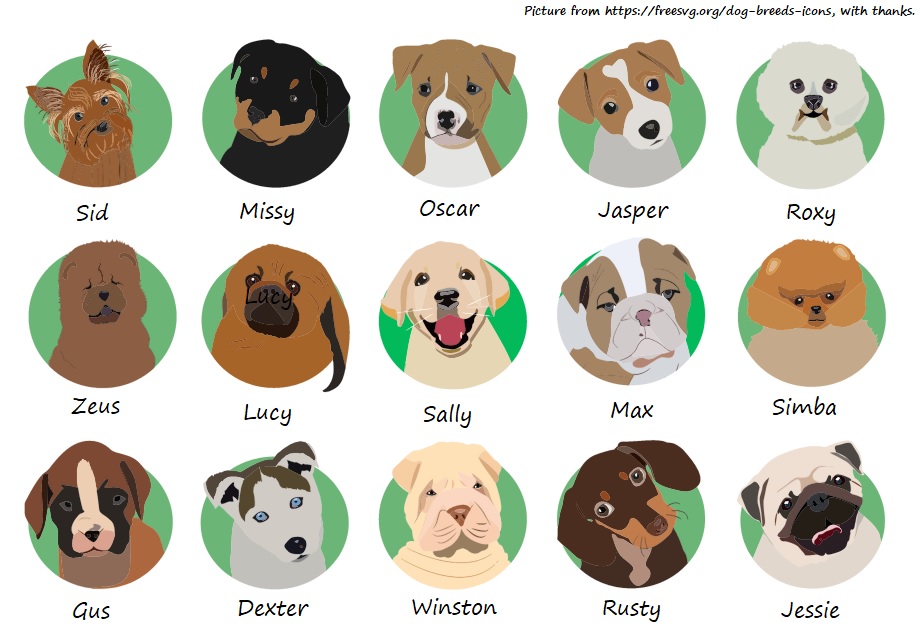A phoneme is like a dog
11 RepliesSome of my best-received blog posts have included analogies to (try to) explain complex ideas. So let’s try another one. A phoneme is like a dog.
We start developing a concept of what a dog is when we first encounter dogs, and hear people call them ‘dog’ (or ‘doggie’, for nice, safe-to-pat ones). One-year-olds then often start calling all four-legged mammals ‘doggie’ (and all large birds ‘duck’).
Over time, we gather data about the main, consistent, observable features of dogs: four legs, two ears, up-turned tail, fur, non-retractable claws, carnivorous, able to bark, yelp and growl. We do this by paying lots of attention to dogs, which isn’t hard when you’re small, and so many dogs are keen to rush over and lick your face.
Size is not a distinctive feature – a chihuahua and an Irish Wolfhound are both dogs. Fur colour and length don’t help, think Afghan hounds and dachshunds. Most dogs like chasing balls and sticks, and being taken for walks, but in my experience, rescue greyhounds say ‘meh’ to walks, and Pomeranians think it’s my job to fetch. Most dogs are friendly, but I’m not in a rush to pat Rottweilers or Bull Terriers.
The Official Thing that makes a dog a dog (even a three-legged one, or a yodelling Basenji), is the Canis lupus familiaris genome, but we usually learn about that well after we’ve pruned, shaped and fleshed out a robust abstract concept of a dog. Meanwhile, out in the real world, every dog is still different.

Similarly, literate English-speakers all have a concept of the phoneme /s/, though out in the real, live speech stream, where sounds shmoosh together, every /s/ is different. For the jargon buffs, a phoneme is the idea in your head, and the different ways it shows up in real, actual spoken words are called allophones.
The concept of the phoneme /s/ develops at the intersection of speech and print, when kids notice that a particular kind of sound and mouth gesture in spoken words is represented by the letter ‘s’ in written words.
Speech sounds and mouth gestures are a lot harder to pay attention to than dogs. They don’t rush up and lick you in the face. Speech is invisible and transient, and its gestures are mostly automatised and occurring without conscious effort by school entry, though some kids are still fine-tuning the difference between ‘rock/wok’, ‘freezer/freesia’, ‘thin/fin’ and ‘than/van’, and of course many EAL and Team Speech Therapy kids have more difficulties.
Getting children to say words slowly, listen to the sounds, and feel what’s happening in their mouths while writing/reading the relevant spellings is the teaching equivalent of bringing speech sounds up close enough to lick them in the face. It makes them hard to miss.
While gathering their data about /s/, children might notice that in the word ‘see’ it is produced with retracted lips, while the /s/ in ‘soon’ is produced with rounded lips. However, lip position is not a distinctive feature of the phoneme /s/, in the same way that size and colour don’t really help us work out whether an animal is a calf, cat or dog.
You can prolong /s/ as much as you like in dramatic poems about sly slithering snakes. Length in time is not a distinctive feature in Modern English phonology, though it is in some languages, and Old English had short and long vowels, which is why those terms still hang around today.
Since /s/ is produced slightly differently depending on its word position and neighbours, discerning it needs to be taught in different word positions and with different neighbours. That means saying, reading and writing it in a range of phonetic contexts, in words like ‘sat’, ‘sit’, ‘sob’, ‘sum’, ‘gas’, ‘yes’, ‘bus’, ‘best’, ‘desk’, ‘wisp’, ‘cups’, ‘hats’, ‘banks’, ‘spin’, ‘stem’, ‘skin’, ‘swim’, ‘slip’, ‘snip’, and ‘smog’, not just words starting with the sound /s/, or worse, the letter ‘s’ (sometimes including words like ‘sugar’ and ‘shop’, which don’t even contain the sound /s/, see here, here and here). Teaching about /s/ only in initial position is a bit like teaching about dogs but giving labradors as the only example.
Few adults can give the official, Canis-lupis-familiaris-genome type definition of /s/: it’s a voiceless alveolar fricative. But we know what a /s/ sounds and feels like, and notice when it’s moved so far forward it’s become /th/, or so far back it’s become /sh/, just as we have conceptual boundaries to differentiate cats and dogs, even ones as similar as these (yup, these are gratuitous cute animal pictures, welcome to the internet):



A child who has developed a robust, abstract idea of the phoneme /s/ based on saying lots of words with voiceless alveolar fricatives, representing them with the letter ‘s’ in written words, and reading words containing this sound-spelling relationship, is in a good position to go on to learn additional spellings: ‘ss’ in ‘Jessie’, ‘c’ in ‘Lucy’, (half of) ‘x’ in ‘Max’, and so on.
Of course, the dog is not the only animal, and /s/ isn’t the only phoneme. Luckily there are only (about, depending on your accent) 44 phonemes, not thousands of them – I’d never heard of a dhole until I read up on the Canis genus for this blog post. Learning, learning, all the time.
Reading expert Dr Mark Seidenberg and colleagues have produced some recent videos called Phonemes, Speech, and Reading, and Becoming Phonemic, if you’re keen to learn more about what phonemes are (and aren’t) and how children learn about them.



Okay … but if you’re going to give only one kind of dog as an example, it’s a good thing to choose Labradors!
Sorry moderator. If space is precious do delete!
ROFL!
Wow! What a great use of analogy to explain a very tricky concept i.e. reframing the everyday teacher use of ‘phoneme’. Thank you Alison.
This is such a fantastic description of phonemes and how it relates to language and literacy development. I love it!!!
Then you have ‘s’ as ‘z’ … ‘news’, ‘please’, ‘realise’.
This is another step, I know.
A terrific analogy. Thanks for sharing this idea.
Fantastic article Alison and so cleverly written.
Thank-you
Love the metaphor – thanks for the thought and work and passion that go into what you do
/s/ensational Alison! You had me at ‘dogs’!
Amazing (again). Sincere thanks for all that you do to educate, change the culture around how kids learn.